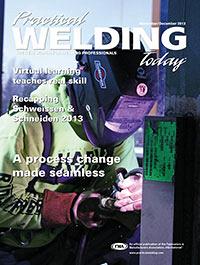- FMA
- The Fabricator
- FABTECH
- Canadian Metalworking
Categories
- Additive Manufacturing
- Aluminum Welding
- Arc Welding
- Assembly and Joining
- Automation and Robotics
- Bending and Forming
- Consumables
- Cutting and Weld Prep
- Electric Vehicles
- En Español
- Finishing
- Hydroforming
- Laser Cutting
- Laser Welding
- Machining
- Manufacturing Software
- Materials Handling
- Metals/Materials
- Oxyfuel Cutting
- Plasma Cutting
- Power Tools
- Punching and Other Holemaking
- Roll Forming
- Safety
- Sawing
- Shearing
- Shop Management
- Testing and Measuring
- Tube and Pipe Fabrication
- Tube and Pipe Production
- Waterjet Cutting
Industry Directory
Webcasts
Podcasts
FAB 40
Advertise
Subscribe
Account Login
Search
Arc Welding 101: Use and identify tungsten electrodes correctly
- By Paul Cameron
- April 22, 2014
- Article
- Arc Welding
Q: Can you tell me how to identify tungsten after the paint is worn off?
Anonymous
A: The two most common processes that use a nonconsumable tungsten electrode are gas tungsten arc welding (GTAW) and plasma arc welding (PAW). These electrodes come in a variety of compositions or alloys, and each composition serves a specific purpose:
- Pure tungsten electrodes (AWS classification EWP) contain 99.50 percent tungsten. They provide good arc stability for AC welding on aluminum and magnesium. Their color designation is green.
- 2 percent thoriated tungsten electrodes (AWS classification EWTh-2) contain 1.70 to 2.20 percent thorium and are the type most commonly used. Unlike pure tungsten, they work exceptionally well for DC electrode negative or straight polarity on carbon and stainless steels. Their color designation is red.
- 2 percent ceriated tungsten electrodes (AWS classification EWCe-2) contain 1.80 to 2.20 percent cerium. They perform best in DC welding at low current settings but can be used in AC processes as well. Their color designation is orange.
- 1.5 percent lanthanated tungsten electrodes (AWS classification EWLa-1.5) contain 1.30 to 1.70 percent lanthanum, or lanthana. These have many of the same advantages as ceriated electrodes and closely resemble the conductivity characteristics of 2 percent thoriated tungsten. Their color designation is gold.
- Zirconiated tungsten electrodes (AWS classification EWZr-1) contain 0.15 to 0.40 percent zirconium. Although ideal for AC welding, under no circumstance is zirconiated recommended for DC welding. Their color designation is brown.
All of these electrodes placed side by side look identical. For that reason, a color code system has been developed to designate each. Short of sending them to a lab for analysis, which can be expensive, once the color designation is gone, there is no way to tell what type of tungsten you're holding.
As the hack TIG welder that I am, I keep short, unmarked tungstens in old military stick match containers. Each container is clearly marked as to the type of tungsten inside. Along with that, I always break down my torch when I'm done and store the tungsten in its designated container.This works for me in my garage. This would not be a good practice in a manufacturing or code environment. Once the marking is removed, the tungsten is not traceable, and you just lost control of your weld process.
Long story short (and it's a little late for that), your best bet is to replace the unmarked electrodes and then begin a practice of maintaining traceability.
About the Author

Paul Cameron
Braun Intertec
4210 Highway 14 East
Rochester, MN 55904
About the Publication
subscribe now

The Welder, formerly known as Practical Welding Today, is a showcase of the real people who make the products we use and work with every day. This magazine has served the welding community in North America well for more than 20 years.
start your free subscription- Stay connected from anywhere

Easily access valuable industry resources now with full access to the digital edition of The Fabricator.

Easily access valuable industry resources now with full access to the digital edition of The Welder.

Easily access valuable industry resources now with full access to the digital edition of The Tube and Pipe Journal.
- Podcasting
- Podcast:
- The Fabricator Podcast
- Published:
- 04/16/2024
- Running Time:
- 63:29
In this episode of The Fabricator Podcast, Caleb Chamberlain, co-founder and CEO of OSH Cut, discusses his company’s...
- Industry Events
16th Annual Safety Conference
- April 30 - May 1, 2024
- Elgin,
Pipe and Tube Conference
- May 21 - 22, 2024
- Omaha, NE
World-Class Roll Forming Workshop
- June 5 - 6, 2024
- Louisville, KY
Advanced Laser Application Workshop
- June 25 - 27, 2024
- Novi, MI
































